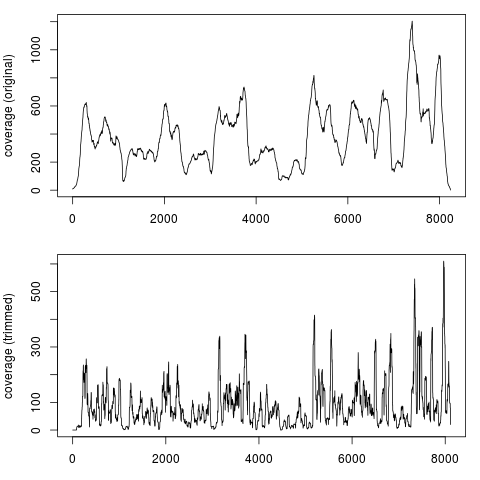Supported by Dr. Osamu Ogasawara and  providing providing  . . |
|
Last data update: 2014.03.03 |
Process reads from High-Troughtput Sequencing experimentsDescriptionThis method allows the processment of NGS nucleosome reads from different sources and a basic manipulation of them. The tasks includes the correction of strand-specific single-end reads and the trimming of reads to a given length. Usage## S4 method for signature 'AlignedRead' processReads(data, type = "single", fragmentLen, trim, ...) ## S4 method for signature 'RangedData' processReads(data, type = "single", fragmentLen, trim, ...) Arguments
DetailsThis function reads a It allows the processment of both paired and single ended reads. In the case of single end reads this function corrects the strand-specific mapping by shifting plus strand reads and minus strand reads towards a middle position where both strands are overlaped. This is done by accounting the expected fragment length ( For paired end reads, mononucleosomal reads could extend more than expected length due to mapping issues or experimental conditions. In this case, the If no value is supplied for In some cases, could be useful trim the reads to a shorter length to improve the detection of nucleosome dyads, easing its detection and automatic positioning. The parameter A special case for single-ended data is setting the Value
NoteIMPORTANT: this information is only used to correct possible strand-specific mapping, this package doesn't link the two ends of paired reads. Author(s)Oscar Flores oflores@mmb.pcb.ub.es See Also
Examples#Load data data(nucleosome_htseq) #Process nucleosome reads, select only those shorter than 200bp pr1 = processReads(nucleosome_htseq, fragmentLen=200) #Now process them, but picking only the 40 bases surrounding the dyad pr2 = processReads(nucleosome_htseq, fragmentLen=200, trim=40) #Compare the results: par(mfrow=c(2,1), mar=c(3,4,1,1)) plot(as.vector(coverage(pr1)[["chr1"]]), type="l", ylab="coverage (original)") plot(as.vector(coverage(pr2)[["chr1"]]), type="l", ylab="coverage (trimmed)") Results
R version 3.3.1 (2016-06-21) -- "Bug in Your Hair"
Copyright (C) 2016 The R Foundation for Statistical Computing
Platform: x86_64-pc-linux-gnu (64-bit)
R is free software and comes with ABSOLUTELY NO WARRANTY.
You are welcome to redistribute it under certain conditions.
Type 'license()' or 'licence()' for distribution details.
R is a collaborative project with many contributors.
Type 'contributors()' for more information and
'citation()' on how to cite R or R packages in publications.
Type 'demo()' for some demos, 'help()' for on-line help, or
'help.start()' for an HTML browser interface to help.
Type 'q()' to quit R.
> library(nucleR)
Loading required package: ShortRead
Loading required package: BiocGenerics
Loading required package: parallel
Attaching package: 'BiocGenerics'
The following objects are masked from 'package:parallel':
clusterApply, clusterApplyLB, clusterCall, clusterEvalQ,
clusterExport, clusterMap, parApply, parCapply, parLapply,
parLapplyLB, parRapply, parSapply, parSapplyLB
The following objects are masked from 'package:stats':
IQR, mad, xtabs
The following objects are masked from 'package:base':
Filter, Find, Map, Position, Reduce, anyDuplicated, append,
as.data.frame, cbind, colnames, do.call, duplicated, eval, evalq,
get, grep, grepl, intersect, is.unsorted, lapply, lengths, mapply,
match, mget, order, paste, pmax, pmax.int, pmin, pmin.int, rank,
rbind, rownames, sapply, setdiff, sort, table, tapply, union,
unique, unsplit
Loading required package: BiocParallel
Loading required package: Biostrings
Loading required package: S4Vectors
Loading required package: stats4
Attaching package: 'S4Vectors'
The following objects are masked from 'package:base':
colMeans, colSums, expand.grid, rowMeans, rowSums
Loading required package: IRanges
Loading required package: XVector
Loading required package: Rsamtools
Loading required package: GenomeInfoDb
Loading required package: GenomicRanges
Loading required package: GenomicAlignments
Loading required package: SummarizedExperiment
Loading required package: Biobase
Welcome to Bioconductor
Vignettes contain introductory material; view with
'browseVignettes()'. To cite Bioconductor, see
'citation("Biobase")', and for packages 'citation("pkgname")'.
> png(filename="/home/ddbj/snapshot/RGM3/R_BC/result/nucleR/processReads.Rd_%03d_medium.png", width=480, height=480)
> ### Name: processReads
> ### Title: Process reads from High-Troughtput Sequencing experiments
> ### Aliases: processReads processReads,AlignedRead-method
> ### processReads,RangedData-method
> ### Keywords: manip
>
> ### ** Examples
>
>
> #Load data
> data(nucleosome_htseq)
>
> #Process nucleosome reads, select only those shorter than 200bp
> pr1 = processReads(nucleosome_htseq, fragmentLen=200)
>
> #Now process them, but picking only the 40 bases surrounding the dyad
> pr2 = processReads(nucleosome_htseq, fragmentLen=200, trim=40)
>
> #Compare the results:
> par(mfrow=c(2,1), mar=c(3,4,1,1))
> plot(as.vector(coverage(pr1)[["chr1"]]), type="l", ylab="coverage (original)")
> plot(as.vector(coverage(pr2)[["chr1"]]), type="l", ylab="coverage (trimmed)")
>
>
>
>
>
>
>
> dev.off()
null device
1
>
|
